Building Scikit-Learn Linear Model: Elasticnet
Introduction Go to Repository
In this notebook we will learn how to use scikit learn to build best linear regressor model. We used gapminder dataset which is related to population in different region and average life expectency. More about our dataset you will see below. We split our datasets into train and test set. We build our model using scikit learn elasticnet linear model. We evaluate our model using test set. We used gridsearch cross validation to optimized our model.
Importing Required Packages
import pandas as pd
import numpy as np
import matplotlib.pyplot as plt
import seaborn as sns
from sklearn.model_selection import cross_val_score
from sklearn.model_selection import train_test_split
from sklearn.linear_model import LinearRegression
from sklearn.linear_model import ElasticNet
from sklearn.metrics import mean_squared_error
from sklearn.model_selection import GridSearchCV
Reading the data in
data = pd.read_csv('data/gm_2008_region.csv')
data.head()
| population | fertility | HIV | CO2 | BMI_male | GDP | BMI_female | life | child_mortality | Region | |
|---|---|---|---|---|---|---|---|---|---|---|
| 0 | 34811059.0 | 2.73 | 0.1 | 3.328945 | 24.59620 | 12314.0 | 129.9049 | 75.3 | 29.5 | Middle East & North Africa |
| 1 | 19842251.0 | 6.43 | 2.0 | 1.474353 | 22.25083 | 7103.0 | 130.1247 | 58.3 | 192.0 | Sub-Saharan Africa |
| 2 | 40381860.0 | 2.24 | 0.5 | 4.785170 | 27.50170 | 14646.0 | 118.8915 | 75.5 | 15.4 | America |
| 3 | 2975029.0 | 1.40 | 0.1 | 1.804106 | 25.35542 | 7383.0 | 132.8108 | 72.5 | 20.0 | Europe & Central Asia |
| 4 | 21370348.0 | 1.96 | 0.1 | 18.016313 | 27.56373 | 41312.0 | 117.3755 | 81.5 | 5.2 | East Asia & Pacific |
Data Exploration
Before we build our model Let’s have a descriptive exploration on our data. We will visualize how each feature is co-related to each other. Also we will visualize some features vs life of our dataset. Visualization will give us better understanding of our data and will help us to select appropriate feature to build our model.
# summerize our data
data.describe()
| population | fertility | HIV | CO2 | BMI_male | GDP | BMI_female | life | child_mortality | |
|---|---|---|---|---|---|---|---|---|---|
| count | 1.390000e+02 | 139.000000 | 139.000000 | 139.000000 | 139.000000 | 139.000000 | 139.000000 | 139.000000 | 139.000000 |
| mean | 3.549977e+07 | 3.005108 | 1.915612 | 4.459874 | 24.623054 | 16638.784173 | 126.701914 | 69.602878 | 45.097122 |
| std | 1.095121e+08 | 1.615354 | 4.408974 | 6.268349 | 2.209368 | 19207.299083 | 4.471997 | 9.122189 | 45.724667 |
| min | 2.773150e+05 | 1.280000 | 0.060000 | 0.008618 | 20.397420 | 588.000000 | 117.375500 | 45.200000 | 2.700000 |
| 25% | 3.752776e+06 | 1.810000 | 0.100000 | 0.496190 | 22.448135 | 2899.000000 | 123.232200 | 62.200000 | 8.100000 |
| 50% | 9.705130e+06 | 2.410000 | 0.400000 | 2.223796 | 25.156990 | 9938.000000 | 126.519600 | 72.000000 | 24.000000 |
| 75% | 2.791973e+07 | 4.095000 | 1.300000 | 6.589156 | 26.497575 | 23278.500000 | 130.275900 | 76.850000 | 74.200000 |
| max | 1.197070e+09 | 7.590000 | 25.900000 | 48.702062 | 28.456980 | 126076.000000 | 135.492000 | 82.600000 | 192.000000 |
# Let's select some of the features to explore more
chosen_data = data[['population', 'fertility', 'HIV', 'CO2', 'GDP', 'child_mortality', 'life']]
chosen_data.head()
| population | fertility | HIV | CO2 | GDP | child_mortality | life | |
|---|---|---|---|---|---|---|---|
| 0 | 34811059.0 | 2.73 | 0.1 | 3.328945 | 12314.0 | 29.5 | 75.3 |
| 1 | 19842251.0 | 6.43 | 2.0 | 1.474353 | 7103.0 | 192.0 | 58.3 |
| 2 | 40381860.0 | 2.24 | 0.5 | 4.785170 | 14646.0 | 15.4 | 75.5 |
| 3 | 2975029.0 | 1.40 | 0.1 | 1.804106 | 7383.0 | 20.0 | 72.5 |
| 4 | 21370348.0 | 1.96 | 0.1 | 18.016313 | 41312.0 | 5.2 | 81.5 |
# We can plot each of these features
chosen_data.hist()
plt.show()
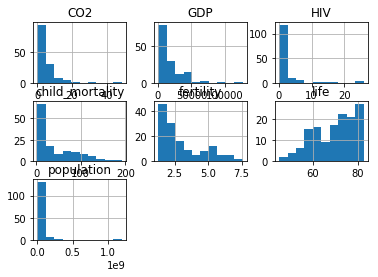
Let’s now plot each of these features vs life, to their relation
plt.scatter(chosen_data.HIV, chosen_data.life)
plt.xlabel('HIV')
plt.ylabel('Life')
plt.show()
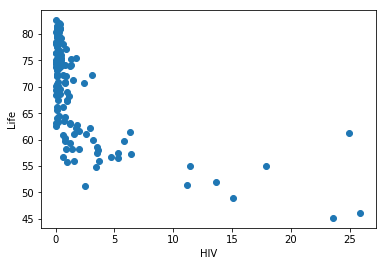
plt.scatter(chosen_data.GDP, chosen_data.life)
plt.xlabel('GDP')
plt.ylabel('Life')
plt.show()
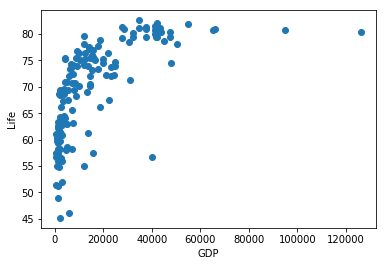
plt.scatter(chosen_data.child_mortality, chosen_data.life)
plt.xlabel('Child Mortality')
plt.ylabel('Life')
plt.show()
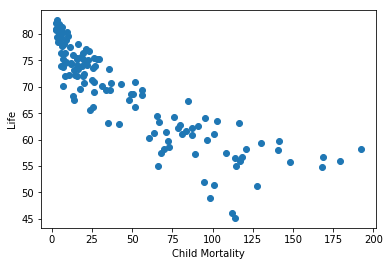
plt.scatter(chosen_data.CO2, chosen_data.life)
plt.xlabel('CO2')
plt.ylabel('Life')
plt.show()
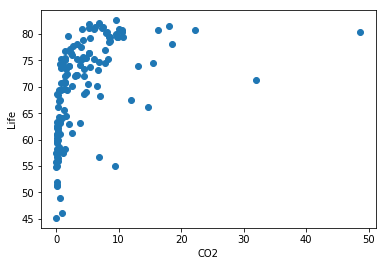
sns.heatmap(data.corr(), square=True, cmap='RdYlGn')
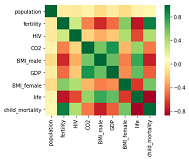
Data preprocessing
We will be using scikit learn to build our model as I mentioned earlier. We have to make sure that there is/are no missing value exist in our dataset. Also we we have to make sure all of our features data are numerical. As categorical data will not be entertained by scikit learn model. In the following we address and fix such issues.
# dertermining any missing value
data.count()
population 139
fertility 139
HIV 139
CO2 139
BMI_male 139
GDP 139
BMI_female 139
life 139
child_mortality 139
Region 139
dtype: int64
# determining andy null value
data.isna().sum()
population 0
fertility 0
HIV 0
CO2 0
BMI_male 0
GDP 0
BMI_female 0
life 0
child_mortality 0
Region 0
dtype: int64
# determing categorical value
data.Region.head()
0 Middle East & North Africa
1 Sub-Saharan Africa
2 America
3 Europe & Central Asia
4 East Asia & Pacific
Name: Region, dtype: object
# Converting categorical to numerical
data = pd.get_dummies(data, drop_first=True)
data.head()
| population | fertility | HIV | CO2 | BMI_male | GDP | BMI_female | life | child_mortality | Region_East Asia & Pacific | Region_Europe & Central Asia | Region_Middle East & North Africa | Region_South Asia | Region_Sub-Saharan Africa | |
|---|---|---|---|---|---|---|---|---|---|---|---|---|---|---|
| 0 | 34811059.0 | 2.73 | 0.1 | 3.328945 | 24.59620 | 12314.0 | 129.9049 | 75.3 | 29.5 | 0 | 0 | 1 | 0 | 0 |
| 1 | 19842251.0 | 6.43 | 2.0 | 1.474353 | 22.25083 | 7103.0 | 130.1247 | 58.3 | 192.0 | 0 | 0 | 0 | 0 | 1 |
| 2 | 40381860.0 | 2.24 | 0.5 | 4.785170 | 27.50170 | 14646.0 | 118.8915 | 75.5 | 15.4 | 0 | 0 | 0 | 0 | 0 |
| 3 | 2975029.0 | 1.40 | 0.1 | 1.804106 | 25.35542 | 7383.0 | 132.8108 | 72.5 | 20.0 | 0 | 1 | 0 | 0 | 0 |
| 4 | 21370348.0 | 1.96 | 0.1 | 18.016313 | 27.56373 | 41312.0 | 117.3755 | 81.5 | 5.2 | 1 | 0 | 0 | 0 | 0 |
Creating train and test dataset
Train/Test Split involves splitting the dataset into training and testing sets respectively, which are mutually exclusive. After which, we will train with the training set and test with the testing set. This will provide a more accurate evaluation on out-of-sample accuracy because the testing dataset is not part of the dataset that have been used to train the data. It is more realistic for real world problems.
This means that we know the outcome of each data point in this dataset, making it great to test with! And since this data has not been used to train the model, the model has no knowledge of the outcome of these data points. So, in essence, it is truly an out-of-sample testing.
# Choosing target feature
y = data[['life']]
print(y.head(3))
# Choosing input features
X = data.drop(data[['life']], axis=1)
print(X.head(3))
life
0 75.3
1 58.3
2 75.5
population fertility HIV CO2 BMI_male GDP BMI_female \
0 34811059.0 2.73 0.1 3.328945 24.59620 12314.0 129.9049
1 19842251.0 6.43 2.0 1.474353 22.25083 7103.0 130.1247
2 40381860.0 2.24 0.5 4.785170 27.50170 14646.0 118.8915
child_mortality Region_East Asia & Pacific Region_Europe & Central Asia \
0 29.5 0 0
1 192.0 0 0
2 15.4 0 0
Region_Middle East & North Africa Region_South Asia \
0 1 0
1 0 0
2 0 0
Region_Sub-Saharan Africa
0 0
1 1
2 0
# Create train and test sets
X_train, X_test, y_train, y_test = train_test_split(X,y, test_size=0.4, random_state=42)
Building and Evaluating model
As mentioned at the beginning, we are using elasticnet and grid search Cross validation. You can find great explanation in scikit-learn documentation.
# Create the hyperparameter grid
l1_space = np.linspace(0, 1, 30)
param_grid = {'l1_ratio': l1_space}
# Instantiate the ElasticNet regressor: elastic_net
elastic_net = ElasticNet()
# Setup the GridSearchCV object: gm_cv
gm_cv = GridSearchCV(elastic_net, param_grid, cv=5)
# Fit it to the training data
gm_cv.fit(X_train, y_train)
# Predict on the test set and compute metrics
y_pred = gm_cv.predict(X_test)
r2 = gm_cv.score(X_test, y_test)
mse = mean_squared_error(y_test, y_pred)
print("Tuned ElasticNet l1 ratio: {}".format(gm_cv.best_params_))
print("Tuned ElasticNet R squared: {}".format(r2))
print("Tuned ElasticNet MSE: {}".format(mse))
Tuned ElasticNet l1 ratio: {'l1_ratio': 0.0}
Tuned ElasticNet R squared: 0.8697529413665848
Tuned ElasticNet MSE: 9.837193188072188
